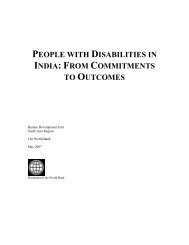FREE Download - TARSHI
FREE Download - TARSHI
FREE Download - TARSHI
You also want an ePaper? Increase the reach of your titles
YUMPU automatically turns print PDFs into web optimized ePapers that Google loves.
trustworthiness of the translated version. Additionally, as most of the data collection has been done in<br />
the local language of the region, the material collected was translated into English before it could be<br />
coded and analysed. However, again, none of the studies mentions whether the responses were<br />
back-translated. Admittedly, this procedure is expensive, and its omission is not surprising in the light of<br />
scarce funding for sexuality research.<br />
Data collection: Very few studies have presented details of the procedures of data collection and<br />
analysis. Studies that do so include Abraham and Kumar's (1999) study on the sexual experiences of<br />
college students, Grenon's (1996) study on gender relations and illness management behaviour, Grenon<br />
and Mawji's (1996) study on perceptions of STDs, and Khanna et al's (1998) study on sexual coercion<br />
and reproductive health. Some of the good practices in the data collection procedures employed in<br />
these studies include:<br />
• careful selection and training of interviewers - awareness of gender issues, etc<br />
• obtaining informed consent for both interviews and recording<br />
• ensuring privacy and confidentiality<br />
• conducting repeat interviews with increasing sensitivity<br />
• ongoing analysis for further refinement of research questions/checklists<br />
• providing emotional support/counselling for the interviewers as well as the respondents<br />
• conducting review sessions<br />
Analysis: A few qualitative studies have identified and categorised emerging themes based on verbatim<br />
responses, and have developed case profiles from an emic (2) perspective (Chandiramani, 1998;<br />
Khanna, 2000; Sodhi, 2000). Including local terminology, expressions and verbatim quotes gives voice<br />
to the respondents and provides greater authenticity in qualitative studies. It also offsets the tendency<br />
to perpetuate stereotypes and conventional notions about gender, class and ethnic differences<br />
(Petchesky, 2000). The findings generated from some of the qualitative studies adequately reflect<br />
cultural sensitivity and richness. Those studies (Amin et al, 1996, 1997; Chandiramani, 1998; Grenon,<br />
1996; Khanna, 1998; Joshi, 1997; Sodhi, 2000; Verma, 2000) that have presented local terminologies<br />
and expressions as well as the verbatim responses of participants, have successfully illustrated the<br />
participants' socio-cultural perspectives on sexuality. Other studies (e.g. Amin et al, 1997) have<br />
analysed the emotional responses of the participants. Some of these qualitative studies have used<br />
computer packages such as Anthropac, DtSearch, and Ethnograph for text analysis, but none have<br />
indicated how these packages influenced the final analysis. Interpretative comments have largely<br />
disregarded the complexity of the issue or the context of the group being researched. A notable<br />
exception is George's (2000) study that provides a good contextual description. Most researchers rarely<br />
refer to contradictions or differences from other findings.<br />
Some of the researchers have revealed how the research context influences the responses of<br />
participants. They have highlighted how peer pressure has influenced the way interviewees responded<br />
in group situations as compared to individual interviews. These differences were often gendered. In the<br />
SARTHI study (Amin et al. 1997), boys tended to brag about their sexual experiences in groups, while<br />
they expressed fears and insecurities in private. In contrast, young women were more likely to express<br />
ignorance of sexual matters in groups, and proved more knowledgeable when interviewed individually<br />
(Ubale et al. 1996-97).<br />
The analysis in studies such as those by George (2000) and Maitra and Schensul (2000) reveal how<br />
respondents have different 'stories' to express multiple levels of understanding of their sexuality, rather<br />
than one story that is more true than any other.<br />
(2) Emic: Ethnographic research attempts to understand human beliefs and behaviour from the point of view of the people being studied. This is known as<br />
taking the emic or "insider" perspective (Gittelsohn et al. 1995).<br />
14










